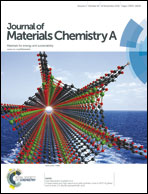Nanocavity-engineered Si/multi-functional carbon nanofiber composite anodes with exceptional high-rate capacities†
Abstract
A facile and scalable electrospinning method is employed to fabricate in situ N-doped, porous graphitic carbon nanofibers (CNFs) containing Si nanoparticles surrounded by nanocavities as durable high-rate Li-ion anodes. Nanocavities are created within the graphitic carbon spheres by electroless etching of the Si nanoparticles, which function not only as buffer to accommodate the volumetric expansion of Si upon lithiation but also as a conducting network for fast electron/ion transport. The Fe3C catalyst simultaneously formed within the fiber promotes the formation of highly graphitic carbon structures while the nitric acid etchant in situ generates functional CNFs with numerous mesopores and oxygenated functional groups, offering extra reaction sites for Li ions. With the ameliorating structural features acting synergistically, the resultant C–Si/F–CNF electrode delivers an exceptional initial reversible capacity of 1548 mA h g−1 at 0.1 A g−1, and remarkable high-rate capacities of 770 and 580 mA h g−1 at 2.0 and 5.0 A g−1 after 70 cycles with excellent capacity retention.


 Please wait while we load your content...
Please wait while we load your content...